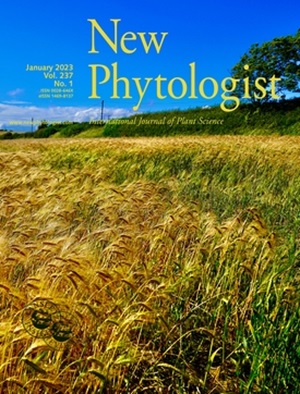丛枝菌根真菌为大豆招募恶臭假单胞菌搭建了桥梁
IF 8.3
1区 生物学
Q1 PLANT SCIENCES
引用次数: 0
摘要
根际微生物组的组装决定了其对植物适应性的功能。尽管丛枝菌根真菌(AMF)与植物促生根瘤菌(PGPR)之间的相互作用在植物生长和抗病性中发挥着重要作用,但对植物与AMF、PGPR之间形成的共生体成员之间的分工以及碳源的流动研究仍然不足。为了解决上述问题,本研究以大豆(Glycine max)、mosseae和Pseudomonas putida KT2440为研究对象,建立根瘤菌相互作用,并阐明这些成分之间的信号交换和分工。mosseae通过分泌半胱氨酸作为信号分子吸引p.p . putida KT2440,促进p.p . putida KT2440在大豆根际定植。定植的恶臭p.p . putida KT2440可以刺激寄主植物的l-色氨酸分泌,并在l-色氨酸刺激下导致参与甲基吲哚-3-乙酸(Me-IAA)转化为IAA的基因上调。总的来说,我们通过跨界相互作用破译了根际微生物群落组装的三方机制。本文章由计算机程序翻译,如有差异,请以英文原文为准。
Arbuscular mycorrhizal fungi build a bridge for soybeans to recruit Pseudomonas putida
- The assembly of the rhizosphere microbiome determines its functionality for plant fitness. Although the interactions between arbuscular mycorrhizal fungi (AMF) and plant growth-promoting rhizobacteria (PGPR) play important roles in plant growth and disease resistance, research on the division of labor among the members of the symbionts formed among plants, AMF, and PGPR, as well as the flow of carbon sources, is still insufficient.
- To address the above questions, we used soybean (Glycine max), Funneliformis mosseae, and Pseudomonas putida KT2440 as research subjects to establish rhizobiont interactions and to elucidate the signal exchange and division of labor among these components.
- Funneliformis mosseae can attract P. putida KT2440 by secreting cysteine as a signaling molecule and can promote the colonization of P. putida KT2440 in the soybean rhizosphere. Colonized P. putida KT2440 can stimulate the l-tryptophan secretion of the host plant and can lead to the upregulation of genes involved in converting methyl-indole-3-acetic acid (Me-IAA) into IAA in response to l-tryptophan stimulation.
- Collectively, we decipher the tripartite mechanism of rhizosphere microbial community assembly via cross-kingdom interactions.
求助全文
通过发布文献求助,成功后即可免费获取论文全文。
去求助
来源期刊

New Phytologist
生物-植物科学
自引率
5.30%
发文量
728
期刊介绍:
New Phytologist is an international electronic journal published 24 times a year. It is owned by the New Phytologist Foundation, a non-profit-making charitable organization dedicated to promoting plant science. The journal publishes excellent, novel, rigorous, and timely research and scholarship in plant science and its applications. The articles cover topics in five sections: Physiology & Development, Environment, Interaction, Evolution, and Transformative Plant Biotechnology. These sections encompass intracellular processes, global environmental change, and encourage cross-disciplinary approaches. The journal recognizes the use of techniques from molecular and cell biology, functional genomics, modeling, and system-based approaches in plant science. Abstracting and Indexing Information for New Phytologist includes Academic Search, AgBiotech News & Information, Agroforestry Abstracts, Biochemistry & Biophysics Citation Index, Botanical Pesticides, CAB Abstracts®, Environment Index, Global Health, and Plant Breeding Abstracts, and others.
 求助内容:
求助内容: 应助结果提醒方式:
应助结果提醒方式:


